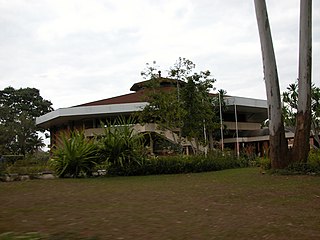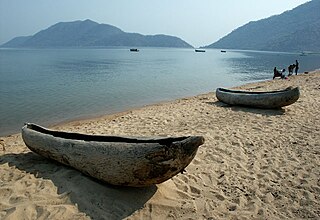The History of Malawi covers the area of present-day Malawi. The region was once part of the Maravi Empire. In colonial times, the territory was ruled by the British, under whose control it was known first as British Central Africa and later Nyasaland. It became part of the Federation of Rhodesia and Nyasaland. The country achieved full independence, as Malawi, in 1964. After independence, Malawi was ruled as a one-party state under Hastings Banda until 1994.

Zomba is a city in southern Malawi, in the Shire Highlands. It is the former capital city of Malawi.

Mangochi is a township in the Southern Region of Malawi. Located near the southern end of Lake Malawi, in colonial times it used to be called Fort Johnston. As of 2018 it has a population of 53,498.

Monkey Bay or Lusumbwe is a town in Mangochi which is in the Mangochi District in the Southern Region of Malawi. The town is on the shore of Lake Malawi and is one of the main ports on Lake Malawi. The population of Monkey Bay was 14,955 according to the 2018 census. Monkey Bay is 206 kilometres (128 mi) from Lilongwe, Malawi's capital city, and 253 kilometres (157 mi) from Blantyre. Monkey Bay is a tourist resort and is often travelled through on the road to Cape Maclear.
Dedza is a district in the Central Region of Malawi. It covers an area of 3,624 km.² to the south of the Malawi capital, Lilongwe, between Mozambique and Lake Malawi. The capital is Dedza.
Kasungu is a district in the Central Region of Malawi. The capital is Kasungu. The district covers an area of 7,878 km², borders Zambia and has a population of 842,953.
Likoma District is the least populous district of Malawi, which consists of two separate exclaves of Malawi situated within Mozambican waters in Lake Malawi. It consists of two main islands, Likoma and Chizumulu. It is a district in the Northern Region of Malawi. The capital is Likoma.

Machinga is a district in the Southern Region of Malawi. The capital is Machinga. The district covers an area of 3,771 km.² and has a population of 369,614.
Mulanje is a district in the Southern Region of Malawi. The capital is Mulanje. The district covers an area of 2,056 km.² and has a population of 428,322. It is also known for its tea growing industry and Mount Mulanje which is one of the highest peaks in Southern Africa.

Ntcheu is a district in the Central Region of Malawi. It borders with the country of Mozambique. The district headquarters is Ntcheu, known as BOMA in the local language, but is most commonly called Mphate. It is run by Yeneya, the village headman. The district covers an area of 3,424 km.² and has a population of 659,608 people according to the 2018 Malawi Population and Housing Census. The Ntcheu district lies around halfway between Malawi's majors cities of Blantyre and Lilongwe - the capital city.
Ntchisi is a district in the Central Region of Malawi. The district covers an area of 1,655 km.² and has a population of 317,069. The capital is Ntchisi.
Salima is a district in the Central Region of Malawi. The capital is Salima. The district covers an area of 2,196 km.² and has a population of 478,346. The beach at Senga Bay is the weekend retreat of many from the capital, Lilongwe, and has hosted the annual Lake of Stars festival since 2008, when it was moved from Chintheche in order to be less remote. There is a range of accommodation options in the area, though most are a few km off the main road.

Zomba District is one of twelve districts in the Southern Region of Malawi, surrounded by the districts of Chiradzulu, Blantyre, Mulanje, Phalombe, Machinga, Balaka and the Republic of Mozambique to the east. The total land area is 2,363 km2, representing three percent of the total land area of Malawi. The capital is Zomba.
Liwonde National Park, also known as Liwonde Wildlife Reserve, is a national park in southern Malawi, near the Mozambique border. The park was established in 1973, and has been managed by the nonprofit conservation organization African Parks since August 2015. African Parks built an electric fence around the perimeter of the park to help mitigate human-wildlife conflict. In early 2018, the adjacent Mangochi Forest Reserve was also brought under African Parks' management, almost doubling the size of the protected area.

Lake Malawi National Park is a national park at the southern end of Lake Malawi in Malawi, Southeast Africa. It is the only national park in Malawi that was created with the purpose of protecting fish and aquatic habitats. Despite this being its main purpose, Lake Malawi National Park includes a fair amount of land, including a headland, the foreshore and several small rocky islands in Lake Malawi.

Nkhata Bay or just Nkhata is the capital of the Nkhata Bay District in Malawi. It is on the shore of Lake Malawi, east of Mzuzu, and is one of the main ports on Lake Malawi. The population of Nkhata Bay was 14,274 according to the 2018 census. Nkhata Bay is 413 kilometres (257 mi) from Lilongwe, Malawi's capital city, and 576 kilometres (358 mi) from Blantyre, Malawi's second-largest city. Nkhata Bay is the second "busiest resort" on Lake Malawi.

Cape Maclear or Chembe is a town in the Mangochi District of Malawi's Southern Region. The town, on the Nankumba Peninsula, is on the southern shore of Lake Malawi and is the busiest resort on Lake Malawi. Cape Maclear is close to the islands of Domwe, Thumbwe and Mumbo Island on Lake Malawi, and is in Lake Malawi National Park.
Yao is a Bantu language in Africa with approximately two million speakers in Malawi, and half a million each in Tanzania and Mozambique. There are also some speakers in Zambia. In Malawi, the main dialect is Mangochi, mostly spoken around Lake Malawi. In Mozambique, the main dialects are Makale and Massaninga. The language has also gone by several other names in English, including chiYao or ciYao, Achawa, Adsawa, Adsoa, Ajawa, Ayawa, Ayo, Ayao, Djao, Haiao, Hiao, Hyao, Jao, Veiao, and waJao.
Malawi, officially known as the Republic of Malawi, is a country located in southeastern Africa. The country is also referred to as "The Warm Heart of Africa", due to the friendliness of the people.
Lake Malawi Museum is a museum on Lake Malawi in Malawi. Situated in the Old Gymkhana Club and organized by the Society of Malawi since 1971, the museum is located near the Queen Victoria memorial near the Bakili Muluzi Bridge in Mangochi town, Mangochi District, within the Southern Region of Malawi.









